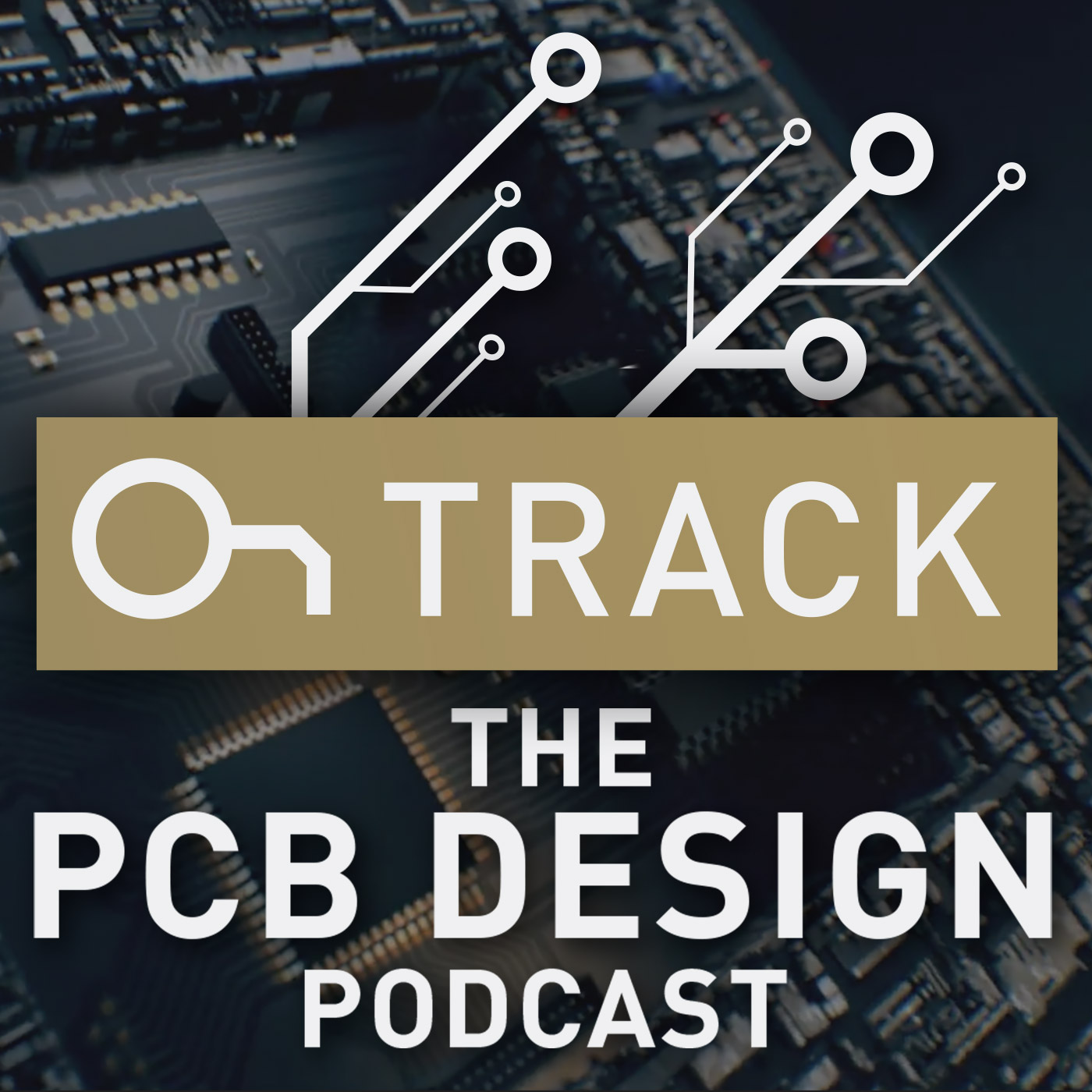Episodes

Tuesday Jun 06, 2023
Better Thermal and Power Efficiency for Your PCB
Tuesday Jun 06, 2023
Tuesday Jun 06, 2023
Better thermal efficiency, how to do better power efficiency, how to reduce losses, how to help people handle those thermal losses? This episode is a real treat.
Our guest Steven Schnier, Systems Engineer for Power Management at Texas Instruments generously shares the different strategies for designing better thermal and power efficient PCB.
Watch through the end, this episode is sure have great tips and strategies that you don’t want to miss.
Show Highlights:
- Introduction to Steven Schnier, Systems Engineer for Power Management at Texas Instruments
- Steven shares that Texas Instrument is currently focusing on better thermal efficiency, how to do better power efficiency, how to reduce losses, how to help people handle those thermal losses
- What is the best strategy in regulating the LDO?
- Eliminating the LDO to lower the noise, but keep in mind that LDO does not solve all the noise issues
- Steven briefly explains the difference between low noise, ripple, and EMI
- Using a ferrite bead filter is one of most common ways to suppress noise and switching frequency
- Steven dives in the details on the appropriate use of ferrites and shares about Texas Instrument’s integrated ferrite bead filter
- Where would you add damping in that pie circuit that you might be putting on the output of that buck converter?
- Steven shares a tip on how to reduce output voltage ripple
- Ferrite beads help with EMI concerns, crosstalk concerns, and transmission line effects, but ultimately to kill the noise and the output ripple
- Steven generously shares different strategies for designing for better thermal and power efficiency
- Various ADC (analogue-to-digital converter) products at Texas Instruments
- When does a multi-phase converter applicable to use?
- Steven talks about the Texas Instruments’ TPS series module equivalents
- BGA vs QFN, when to use what?
- Texas Instruments is going with higher power density, so expect more progress on that
Links and Resources:
- Read Power Integrity related articles
- Read: The Beginner's Guide to PCB Power Integrity: From Board to Package
- Watch related videos:
- Connect with Steven Schnier via Linkedin
- Visit Texas Instrument Website
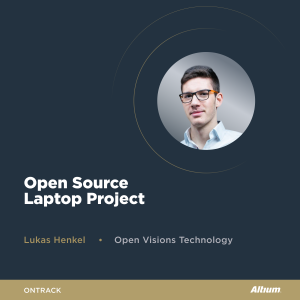
Tuesday May 30, 2023
Inspire and Educate through Open-Source Hardware Products with Lukas Henkel
Tuesday May 30, 2023
Tuesday May 30, 2023
Lukas Henkel, our guest in this episode was already into electronic engineering at age 10.
He will share with us what made him interested in designing electronics, some details about the development of his Open-source laptop project, and will even give us a sneak peek of the actual design development on Altium Designer.
You don’t want to miss this! Watch through the end and be sure to check the additional resources below.
Get Your First Month of Altium Designer® for FREE
Episode Highlights:
-
Lukassz Lawrocki, Technical Marketing Manager at Altium makes a special appearance to explain Altium’s new initiative that encourages and supports electrical engineers to create open-source projects
-
The open source Laptop project by Lukas Henkel is the first project to be supported by this new initiative
-
Introduction to Lukas Henkel
-
Lukas talks about his background and his first electronic project at age 10
-
Robert Feranec and the Altium OnTrack Podcast are just a couple of Lukas’s inspirations for discovering his interest in electronics and PCB design
-
Lukas chose a laptop for his open-source project because of its composition—a variety of components working together
-
Electrical vs mechanical, which one did Lukas find more challenging?
-
The laptop project will have a full aluminum body, which is a cheaper choice for producing prototypes in a smaller volume
-
Lukas talks about why the flex part of the enclosure is one of the challenging parts of his project
-
While there are commercial and open-source tools to help with high-speed signal optimization, complex optimization problems are best solved through a manual process — comparing solutions and comparing the impact of each domain
-
Lukas shares his transition from working with Semikron to his own company, OV Tech
-
Zach and Lukas exchange experiences in running their companies - challenges, projects, and clients
-
Lukas encourages everyone who is interested to learn more about his open-source laptop to follow him on LinkedIn for development updates
-
Design Demonstration via Altium designer
-
Watch for Lukas's next project, the Open Source Smartwatch
Links and Resources:
- Connect with Lukas Henkel via LinkedIn
- Subscribe to Robert Feranec Youtube Channel
- Watch all previous Altium OnTrack Podcast episodes
- Watch related episodes:
Read: Open Source Hardware & PCB Projects in Altium Designer

Thursday May 25, 2023
The Emerging Role of Mexico in the Electronics Supply Chain
Thursday May 25, 2023
Thursday May 25, 2023
The globalization of the electronics supply chain has been a widely discussed topic, and having Andrew Hupert, an esteemed supply chain consultant, in this episode is incredibly timely.
In this insightful discussion, Andrew sheds light on Mexico's distinctive edge in electronics production. Furthermore, he provides us with a comprehensive comparison of the logistical aspects between Mexico's and China's production processes.
Key Highlights:
- Introduction to Andrew Hupert, professor at Holt University and Supply Chain Consultant
- Andrew talks about his career in cross-cultural negotiation. From China to Thailand, Vietnam, and now to Mexico
- Compliance costs are becoming unmanageable, and logistics becoming more unpredictable, these are just a couple of the challenges in the electronics supply chain
- NAFTA (North America Free Trade Agreement ) aka USMCA, the US, Mexico, and Canada agreement puts Mexico on top of the list as far as production sites for large-scale factories
- US trade agreement with Columbia, is it possible?
- Guadalajara is in the process of becoming the software center in Mexico
- Andrew describes the challenges of sourcing electronics products from Mexico
- In China, one person knows people who can give you all the necessary connections to start and finish a project, meanwhile in Mexico, people will keep their mouths shut
- The level of workmanship in Mexico is high, however, project management is very poor
- The auto industry is the kind of business that is built for Mexico. American automakers have been producing automobiles in Mexico for over 70 years
- Mexico has EMEC which allows companies to bring in equipment, materials, raw materials, or components, all of it duty-free provided they ship it out or export it and not for sale in Mexico
- Andrew gives his insight on what the supply chain will look like
- Only a certain percentage of the electronics production will move out of China to Mexico
- Sophisticated design based in the US such as Texas, Arizona, California, and Mexica can handle the assembly
- Apple is moving its production to India
- “India is a tough one”, Andrew explains the challenges in producing electronics in India
- GM (General Motors) moved all their electric vehicle manufacturing to Mexico
- It’s hard to get business intelligence on Mexico, Andrew encourages companies to plan their transition or hire a project manager to do the legwork

Friday May 12, 2023
New Opportunities for PCB Education with John Watson
Friday May 12, 2023
Friday May 12, 2023
Today we're thrilled to be joined by John Watson, Customer Success Manager at Altium. He and Tech Consultant Zach Peterson chat about the importance of education for designers, what it's like working with students, and what new opportunities there are for PCB designers in today's market.
Get Your First Month of Altium Designer® for FREE
Key Highlights:
- Introduction to John Watson, Altium Customer Success Manager
- John talks about his teaching profession at Palomar College in San Marcos, California where he teaches Basic and Advanced PCB design
- The Middle College Program at Palomar College was created for junior and senior high school students to give them a head start in taking college courses
- The demand for PCB designers is driven by a lack of interested individuals in the industry
- An increasing number of young engineers are drawn to computer science and software development, while the fields of hardware, electrical engineering, and PCB design are experiencing a declining interest
- John elaborates on the content covered in his comprehensive 32-week course, encompassing both fundamental and advanced aspects of PCB design
- Companies are losing their talent every single day through retirement. Now more than ever, there is a huge need to fill the pipeline
- John shares his early days as an electrician on the kitchen floor with a screwdriver in the toaster
- John finds Ai concerning, and he doesn’t allow it in his class
- John describes the kind of students he has in his class
- Overanalyzing is a typical problem for electrical engineers
- PCBs are works of art
- Zach describes a PCB designer as a “constraint manager”
- John works with different organizations to give the students a leap towards their next step after they finished his 32-week course
- From a janitor to a PCB designer, a winning moment to one of John’s students
- Give back no matter what level we’re at, this is John’s message to his peers and everyone in the electronics industry
- There are 25 spots available in John’s PCB design course, those who will not make it will be on the waiting list. You can check more information here.
Links and Resources:
- Connect with John Watson on LinkedIn
- Visit the Palomar College Website
- Check out John Watson's PCB design course outline here
- Read John Watson's Blogs
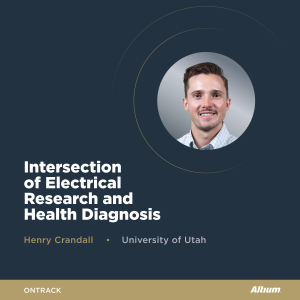
Thursday Apr 27, 2023
Making Smart Wearable Devices Smarter
Thursday Apr 27, 2023
Thursday Apr 27, 2023
Making wearable smart devices smarter, is one of the heavily invested research in the tech industry today.
Our guest Henry Crandall, a National Science Foundation graduate research fellow and Ph.D. candidate at the University of Utah talks about his electrical research applied to human health monitoring and diagnosis. He will also briefly talk about his involvement in the IEEE, BioHive Utah, and his exciting role as a student board member in the IPC.
Show Highlights:
- Introduction to Henry Crandall, his research, and involvement with IPC
- Henry’s research focuses on the intersection of electrostatic and biology. How electrical applications can help diagnose disease and monitor health care condition
- How Henry’s research relates to Elon Musk’s “Neuralink”
- What is Neural Engineering?
- Bioimpedance and non-invasive sensor products are already available through wearable health devices just like the smartwatches
- Henry explains briefly the difference between surface measurement and penetration depth
- Photoplethysmography is what you called the green lights on the back of your smartwatches, it uses light to monitor the cardiovascular system
- Henry’s current research in a nutshell: a Bioimpedance sensor to monitor blood pressure
- One of Henry’s goals in his research is to collect as much data and come up with an algorithm that will help smart devices to become even smarter
- Major tech companies are investing heavily in research that could help make wearable smart devices gather actual clinically relevant data
- Henry talks about his involvement in the IPC as a student member of the IPC Board of Directors
- Both Zach and Henry share their experience with the IEEE
- As a student member of the IPC board of directors, Henry gets involved in decision-making regarding governance, the strategy, and the financial sides of the organization
- IPC has definitely prioritized and put a lot of effort to attract the youth to engineering
- Henry with a health tech focus start-up called BioHive Utah
Links and Resources
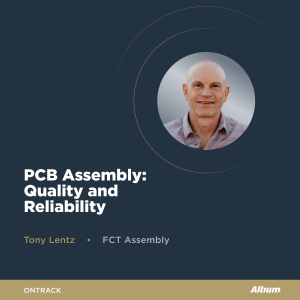
Tuesday Apr 18, 2023
Solder Formula for High Quality and Reliability PCB
Tuesday Apr 18, 2023
Tuesday Apr 18, 2023
Quality and reliability are a big deal when designing PCB for assembly. Our guest Tony Lentz, Chemist and Field Applications Engineer at FCT Solder will bring us to the PCB manufacturing space while tackling solder beyond basic thermodynamics and composition.
Listen or watch through the end. This is a great opportunity for PCB designers to learn about soldering products that are used for printed circuit board assembly.
Episode Highlights:
-
Introduction to Tony Lentz, his background, and role as a Chemist and Field Applications Engineer at FCT Solder
-
Tony talks about how they work with their clients to achieve best quality when manufacturing their PCBs
-
Diving into the chemistry side of things, Tony tackles about how the blending of different metal alloys, additives, and different inter-metallics to that solder joint composition, the pads, and the components can affect the overall reliability of the PCB
-
With the automotive industry’s growing electronic demands, thermal testing cycles are expanding aggressively. Recently between negative 40C to 175 C!
-
Tony briefly explains the different worlds involving PCB manufacturing and assembly: solder company, plating company, components manufacturing, board manufacturing, assembly and the list goes on
-
What is tombstoning?
-
Head on pillow on a BGA is another difficult defect to get rid of, Tony explains what can cause this problem
-
Expert Tip: A rule of thumb for large thermal pads is to cut it down somewhere between 60 and 80% of the total area covered with solder paste and then break that deposit up with some window pane type openings going through it
-
Are hybrid solder reliable?
-
The stability of solder alloys can differ based on the different kinds of metals, components and PCB surface finish
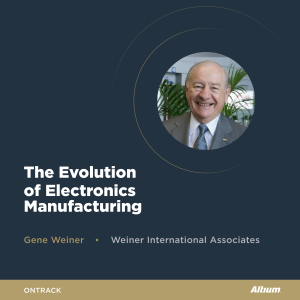
Wednesday Apr 12, 2023
PCB Manufacturing: Then and Now
Wednesday Apr 12, 2023
Wednesday Apr 12, 2023
Let’s walk down memory lane and discover how circuit boards are being manufactured back in the 50s.
In this episode, we have the pleasure to have Gene Weiner, a true gem in the industry! This is a rare opportunity to learn from an expert who has helped shape the electronics industry for more than 60 years now.
Watch through the end, and make sure to check out the show notes and additional resources below.
Get Your First Month of Altium Designer® for FREE
- Introduction to Gene Weiner and a glimpse of his illustrious career in the electronics industry beginning in 1956
- Gene retrospects vividly how they used to do 3D printing and additive back in the 50s
- What would interest a young man to go down the path of electronics manufacturing back in the 50’s? Gene shares his career experience and what sparked his interest in electronics
- 1975 marked the beginning of electronic manufacturing automation development outside the US
- Captive operations versus outsourcing — a lot of electronics companies chose cost reduction over maintaining their own manufacturing operations
- Gene gives his insight about moving some manufacturing facilities to Latin American countries like Mexico and Columbia
- What does it take to bring manufacturing back to the US?
- Just building chips in America without building the rest of the supply chain here just lengthen the supply chain. Gene stresses that volume, demand, incentives, and continuous government programs are necessary to make anchoring a success
- Gene suggests that partnering is better than hiring. Partner with talents who share a mutual vision with the company, and share benefits together
Links and Resources:
- Connect with Gene Weiner on LinkedIn
- Visit Weiner International Associates' website
- Watch the related OnTrack episodes

Tuesday Apr 11, 2023
Reverse Engineering: Is it Worth it?
Tuesday Apr 11, 2023
Tuesday Apr 11, 2023
Pierce Design’s Ethan Pierce will share his insight into reverse engineering with printed circuit assemblies. We will also discuss firmware reverse engineering.
Get Your First Month of Altium Designer® for FREE
Show Highlights:
- Introduction to Ethan Pierce and a quick preview of his upcoming webinar with the PCEA regarding reverse-engineering
- How to acquire reverse-engineering skill sets?
- Retrofitting a system versus creating a net new ecosystem of products
- Is reverse engineering cost-effective?
- Ethan advises designers to keep records and documentation as much as possible. “take as many pictures, take as many pictures, photos, notes.”
Links and Resources:
- Connect with Ethan Pierce on LinkedIn
- Visit Pierce Design's website
- Register for Ethan Pierce's Webinar: Reverse Engineering PCBs: How to Recreate a Lost Design
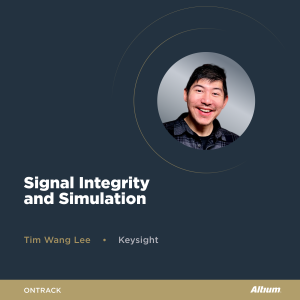
Tuesday Mar 28, 2023
System Level Qualification in Simulation
Tuesday Mar 28, 2023
Tuesday Mar 28, 2023
In this OnTrack episode, we are very excited to bring you Tim Wang Lee, a Signal Integrity Application Scientist and the High-Speed Digital Application Product Manager at Keysight.
Tim will share his early days as a prodigy with Dr. Eric Bogatin. We will also discuss the importance of simulation and measurement to achieve signal integrity for your PCB design.
Get Your First Month of Altium Designer® for FREE
Watch this episode here
Show Highlights:
- Tim Wang Lee Introduction
- Tim talks about Dr. Eric Bogatin as his mentor, the knowledge about simulation and signal integrity especially rule number nine
- A favorite phrase GIGO (garbage in garbage out) according to Tim is his way of understanding his intentions and asking questions before diving into a project
- Tim with Mike Russo, initiated simulation and measurement workflow seminars and webinars to help educate the importance of measurements and simulation to back it up
- What is a Virtual Prototype?
- Where to start with a system-level qualification in simulation?
- Tim explains what an EP Scan (Electrical Performance Scan) does
- Keysight is also now focusing on Power Integrity and Heidi Barnes is one of the leading experts in the Power Integrity ecosystem
- Next step for Keysight is to aid PCB designers in not only generating results but also fixing the issues
Links and Resources:
-
Watch Related Podcast Episode:
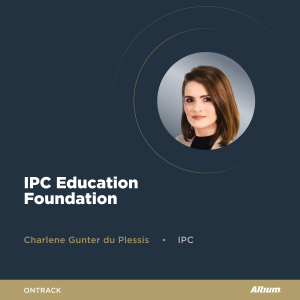
Wednesday Mar 22, 2023
Promoting the Electronic Industry to Younger Generation
Wednesday Mar 22, 2023
Wednesday Mar 22, 2023
IPC continues to develop resources to bring awareness about the electronics industry to the young generation.
In this episode, we are very fortunate to have Charlene Gunther, the Senior Director of the IPC Education Foundation. We will talk about IPC’s efforts to involve students in engaging activities that will introduce the electronic industry to them as early as high school.
Join us and watch through the end. We added some great resources below so be sure to check them out.
Get Your First Month of Altium Designer® for FREE
Episode Highlights:
- Charlene Gunther introduction and a brief overview of her role as the Senior Director of the IPC Foundation
- Charlene talks about the IPC three pillars: awareness, engagement, and connections
- The IPC launched the website www.careersinelectronics.com which aims to attract students and job seekers within the electronics industry
- The IPC student chapter plays a big role to attract and involving students in skill development training and networking
- IPC is hosting annual STEM outreach and partners with Title I schools and private institutions to expose high school students to hands-on activities, connecting them with industry, allowing them to solder, to design, to learn about assembly
- Other departments of the IPC that work towards improving accessible education are the Education Department led by Vice President David Hernandez and Chris Mitchell the VP of Advocacy and Government Relations
- The universities’ response to IPC programs has been very positive and they have become more proactive in integrating electronics and manufacturing-related courses into their curriculum
- Be in the loop with the latest IPC Education Foundation announcements, visit www.careersinelectronics.com , subscribe to their newsletter, and follow their social media pages. Students, parents, and employers are encouraged to visit the website
Links and Resources:
- Connect with Charlene Gunter on LinkedIn
- Visit the IPC website
- Visit the Careers in Electronics website
- Learn more about IPC Education Foundation
- Watch related episodes:
- Learn Printed Circuit Board Design
Get Your First Month of Altium Designer® for FREE
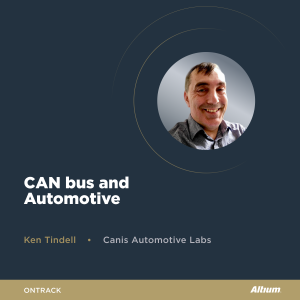
Thursday Mar 16, 2023
Security on CAN bus with Ken Tindell
Thursday Mar 16, 2023
Thursday Mar 16, 2023
In this episode, we will learn so much about embedded CAN bus, for automobile security and performance straight from the water host, Ken Tindell the CTO of Canis Labs.
A lot of interesting facts about cyber security and automobile hacking that you would not want to miss! Watch through the end and make sure to check the additional resources below.
Get Your First Month of Altium Designer® for FREE
Show Highlights:
- Ken Tindell’s background and how he got started with CAN bus and CAN security
- Ken worked with Motorola on designing the MS CAN—the first CAN controller that did all the buffer scheduling correctly
- Ethernet and CAN coexist in autonomous vehicles’ architecture, Ken explains how
- There are two types of major attacks on the CAN bus: attacking the physical wiring and attacking the computer that has access to the wiring. Zac and Ken talk about the mind-blowing advanced techniques of hacking automobiles
- Story of irony. A friend of Ken in automobile cybersecurity had his car stolen
- The biggest car-hacking horror would be through the cloud — cloud-based APIs to phone and at the same time CAN bus protocol hacking on the transceiver pins
- CAN HD, an augmentation for high speed and guarding the CAN bus
- Canis Labs is in the works to provide real solutions for security on CAN bus
Links and Resources:
- Connect with Ken Tindell on LinkedIn
- Visit Canis Automotive Labs' website
- Check out Ken’s Github Page
- Watch related podcast episodes:
Get Your First Month of Altium Designer® for FREE
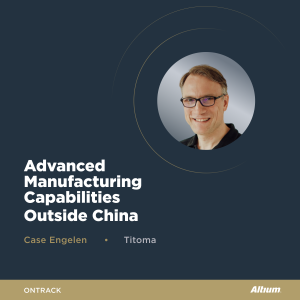
Wednesday Mar 08, 2023
Achieving Diversified Electronics Supply Chain
Wednesday Mar 08, 2023
Wednesday Mar 08, 2023
In this episode, we continue the discussion on diversifying the electronic supply chain. Our guest Case Engelen the CEO of Titoma shares his insight about moving some of the manufacturing to other Southeast Asian countries and South America.
Watch this episode now and check out the show notes and additional resources below.
Show Highlights:
- Case Engelen introduces himself and his company Titoma
- Offshoring, onshoring, and diversifying supply chain, why do the majority of components manufacturing may stay in China for 5 more years?
- Building prototypes and optimizing your design following the factory’s specifications
- Case talks about the importance of component architecture early during the design phase
- The difference between how US and Chinese market their product and their selling strategies
- Diversifying manufacturing in Southeast Asia and South America, Taiwan is a little more expensive than China, but Columbia is more competitive when it comes to cost
- The advanced manufacturing capabilities in China are quite hard to beat
- What is “bifurcation”?
- What does the future of electronics production and sourcing and procurement look like?
Links and Resources:
- Connect with Case Engelen on LinkedIn
- Visit Titoma Website
- Watch the Previous Related Episodes:
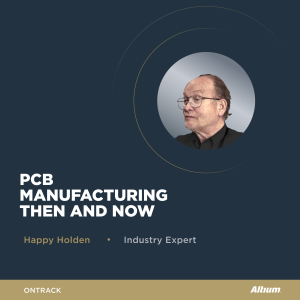
Wednesday Mar 01, 2023
A Lookback to the Evolution of the PCB Industry with Happy Holden
Wednesday Mar 01, 2023
Wednesday Mar 01, 2023
Happy Holden, a legend in the PCB Industry and one of our favorite Altium Industry Expert contributors gives us a trip to his 53 years of experience in the industry. From a chemical engineer, and PCB manufacturing expert to an educator with his countless contribution to the PCB industry’s wealth of knowledge through his books, column, and keynote presentations.
Show Highlights:
- Introduction to Happy Holden and an overview of his career in the PCB Industry
- What drove the PCB manufacturing off-shore? The printed circuit industry has been all over the map, to begin with
- Happy shares his early years in printed circuit manufacturing
- Comparing CAD tools from the 80s and the present – computers, calculators, and software
- Happy talks about photonic circuits back in 1998 and how it is a hundred thousand times more capable than electronic communication and have no signal integrity issue
- HP’s first notebook computer
- Happy retired from HP and moved to Taiwan
- Happy started working at Gentex Michigan
- The beginning of offshoring the PCB manufacturing and fabrication
- In Asia, the printing circuit board is like printing money. It is the most profitable industry in the region
- Globalization took over the industry – emphasis on profit versus jobs
- Diversifying the supply chain. How to bring some of the manufacturing sides of the industry back to the US?
- The $52 Billion budget (CHIPS Act 2022) is just a downpayment to bring the 30 years that were lost
- Would companies start manufacturing their own products?
- How did HDI technology come about?
Links and Resources:
- Connect with Happy Holden on LinkedIn
- Read Happy Holden’s Articles on Altium’s Resource Page
- Read Happy Holden’s Biography on HPMuseum.org
- Buy Happy Holden’s Printed Circuits Handbook, Seventh Edition
- Download FREE Ebook I-Connect007 Publishes Automation eBook by Happy Holden
- Watch the Previous Episode with Happy Holden: The Father of HDI PCBs

Tuesday Feb 21, 2023
Power Testing PCB
Tuesday Feb 21, 2023
Tuesday Feb 21, 2023
Functional testing is when you power up an electronic device for the first time and then perform voltage rail checks and programming of processors, and more. And this is exactly what FixturFab offers their customer.
In this episode, Zach is talking with the co-founders of FixturFab, Duncan Lowder and Joe Selvik. They will have a chat about automated test fixtures and turnkey systems that aid low to medium electronic production to deliver successful devices.
Show Highlights:
- Jow Selvic and Duncan Lowder introduction and engineering backgrounds
- What is FixturFab’s test fixture? Duncan briefly explains how it works – the mechanical, electrical, and software aspects of it
- A turnkey test system designs and delivers specific test cases and dives into detail about how a circuit board was designed and gathers reports
- Bolina an IIOT device deployment engine allows the management of Test Fixtures remotely
- An ideal customer for FixturFab is anyone who designs or manufactures their hardware, the best time to initiate the testing is before finalizing the board layout or during the prototyping phase
- Currently, FixturFab caters to low to medium-volume production, but they definitely are looking forward to eventually being in an automated SMT (Surface Mount Technology) line
- Coming next is the Test System in a Box, the IKEA or the “protolab” for test fixtures
Links and Resources:
- Connect with Joe Selvik on LinkedIn
- Connect with Duncan Lowder on LinkedIn
- Visit FixturFab website
- Read: Generating an Altium Test Point Report
- Watch related episodes:
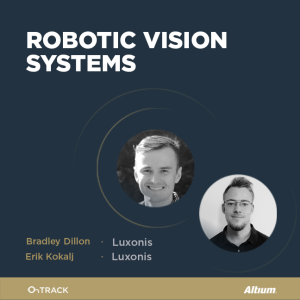
Tuesday Feb 14, 2023
The Rise of AI Interference
Tuesday Feb 14, 2023
Tuesday Feb 14, 2023
In this episode, we are fortunate to have two key personalities at Luxonis, a hardware, firmware, software, AI, and simulation company. Erik Kokalj, director of application engineering at Luxonis, and Bradley Dillon, CEO of Luxonis discuss how and who can benefit from AI technology.
Tune in and make sure to check out the show notes and additional resources below.
Show Highlights:
- Introduction to Luxonis and its founding on April 2019
- The liDAR and radar as an imaging technology, Erik briefly explains the technology behind it
- Bradley shares why they decided to open-source some aspects of their platform and design
- Luxonis’s AI training, AI conversion, and AI deployment onto hardware are all open-source, for their customers can quickly develop their own model and then deploy it on the device itself
- Future design updates, miniaturization, and thermal management
- What are some of the industrial applications that are utilizing the Luxonis imaging technology? Beekeeping was unexpected!
- Robotic applications on robotic cars, Zach and Erik talk about action recognition on top of object recognition
- Bradley talks about series 3 products and what’s coming in terms of capabilities – processing power, more AI inference
Resources and Links:
- Connect with Bradley Dillon on LinkedIn
- Connect with Erik Kokalj on LinkedIn
- Checkout Luxonis Website
- Watch Luxonis featured on Altium Story: How Luxonis uses Altium 365 to innovate AI Vision systems faster
- Connect with Zach Peterson on LinkedIn
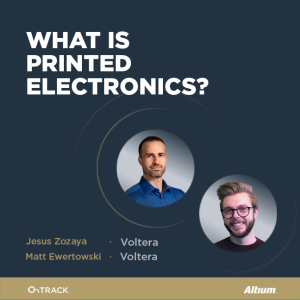
Tuesday Feb 07, 2023
The True Benefits of Printed Electronics
Tuesday Feb 07, 2023
Tuesday Feb 07, 2023
In this episode, we are very excited to have Jesus Zozaya, CEO of Voltera, and Matt Ewertowski, product manager at Voltera. We will discuss pushing the boundaries in electronics design through printed electronics.
Join us and together let’s discover the many benefits of printed electronics from expedited prototyping, proof of concept, and academic research.
Show Highlights:
- Introduction to Jesus Zozaya, CEO of Voltera, and Matt Ewertowski, product manager at Voltera
- Jesus takes the lead in explaining what Voltera does, and introduced their first product – V-one
- Matt explains the difference between Printed Electronics and additive manufacturing process
- Electronics printer pushes the limits and welcomes new possibilities and opportunities for new materials in the electronic design space
- Voltera designed NOVA (their second product) with users in mind, they created a tool that all electrical engineers can utilize regardless of their skills in material science
- Can you do stack-ups using printed electronics?
- Jesus talks about a customer who created heaters directly on the drone’s wings to melt the ice when flying in cold temperature
- A Voltera customer printed electronics directly on a textile (face mask) that will allow a smartphone app to track the level of CO2 on the face mask
- Mark dives deep into the capabilities of NOVA
- Who is the target market for V-one and how does it differentiate from NOVA
- The V-one is seen to be utilize more for prototyping, meanwhile NOVA is popular with academic and R and D research
- Printed electronics do not replace traditional marketing, but it aids to expedite the process of getting the proof of concept done
Links and Resources:
- Connect with Jesus Zezoya on LinkedIn
- Connect with Matt Ewertowski on LinkedIn
- Visit Voletra’s website
- Related Podcast Episodes:
- Connect with Zach Peterson on LinkedIn
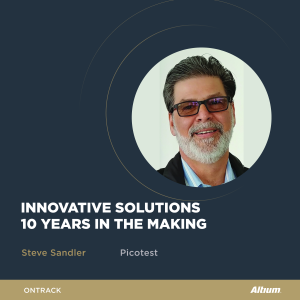
Wednesday Jan 25, 2023
Picotest’s Water-Cooled Probe
Wednesday Jan 25, 2023
Wednesday Jan 25, 2023
Having Steve Sandler in this episode is such a treat! He talks about his presentations at the upcoming DesignCon 2023 in Santa Clara. He gives us a deep dive into some very complex engineering topics, including measuring the PDN Flatness and the state space model.
Show Highlights:
- Steve Sandler is in the running for Engineering of the Year along with Ken Wyatt
- Steve is doing a two-and-a-half-hour tutorial on PSMR, PSOR, and PSMR testing at the DesignCon. Molex and Tektronix are both participating in the live demonstration
- He s also doing a presentation with Heidi Barnes, Bandanin, and Ben Denon
- A lot of conferences are going virtual. The reach is undeniably great, however, what are the pros and the cons? What is valuable to who?
- Steve talks about the conception of Picotest in the US
- Picotest made the very first water-cooled probe which he will be showing at the DesignCon
- Innovative solutions can take decades from conception to fruition, Steve shares his PdD thesis from 2011 that got him ahead of the curve
- Steve deeps dive into the water-cooled probe, how it works, and the problems it eliminates
- 21:34 Power supply stability is critical in space,
- 23:28 What does it mean to quantify the flatness of the PDN? Steve co-authored a paper with Scott Witcher which will be presented at the DesignCon
- 26:25 Steve Sandler wrote a paper in 2015: Target Impedance Limitations and Rogue Wave Assessments on PDN Performance
- 31:29 FACTS! Computers in Space Station are being reset every 40 minutes
- 33:13 Steve stresses the importance of simulation and gives engineers a tip: “Start out with proven models and you'll get there. Get enough confidence.“
- 34:39 Steve explains why it is necessary to find the “Q” to measure PDN Flatness
- 43:19 Innovation could have happened earlier, Steve talks about the typical economic problems that could be hindering technological advancements
- 47:51 Steve gives us a brief deep dive into the “state space model” and what it’s attempting to quantify
Links and Resources:
- Connect with Steve Sandler on LinkedIn
- Visit Picotest website
- Check out Steve Sandler's Books
- Register to DesignCon 2023

Tuesday Jan 17, 2023
Accessible Education for PCB Designers
Tuesday Jan 17, 2023
Tuesday Jan 17, 2023
One of PCEA’s (Printed Circuit Engineering Association) goals is to provide accessible education, affordable to everyone in the electronics industry.
In this episode, we are fortunate to have two passionate educators in the industry, Mike Buetow and Mike Creeden. We will talk about the PCEA’s efforts to use all possible platforms to promote educational programs for design engineers.
PCEA, it's an international network of engineers, designers, fabricators, assemblers…anyone who is involved in printed circuit development. And we promote Printed Circuit Engineering as a profession. We're looking at trying to take information, new design concepts, get them down into the manufacturing side, and then also to communicate those manufacturing constraints and make sure that they are communicated back to the design side. -Mike Buetow
Show Highlights:
- Introduction to PCEA and updates on its acquisition of key assets of UP Media Group
- Mike Buetow talks about the PCB East conference reboot
- Who can benefit from PCEA’s educational initiatives?
- Mike Creeden emphasizes the importance of in-person learning. “Online is good, but it lacks some retention…but in-person learning, you retain more,” he explains.
- To collaborate, educate and inspire is what’s behind PCEA educational efforts
- PCEA is a volunteer-driven organization
- Mike Creeden will be at the https://www.ipcapexexpo.org/in San Diego
- Mike Creeden debunks misconceptions about PCB manufacturing facilities, the skills involved, the compensation, and more
- There are some issues in design education around packaging, the Insulectro booth at IPC Apex 2023 will offer valuable knowledge about packaging
- PCEA membership is free, you can register here
- Mentorship programs are something to look forward to
- Currently, PCEA has chapters in Europe, Mexico, Canada, Australia, and across the United States
Links and Resources:
- Visit PCEA’s website
- Connect with Mike Creeden on LinkedIn
- Connect with Mike Buetow on LinkedIn
- Watch Previous Related Episodes:
Get Your First Month of Altium Designer® for FREE
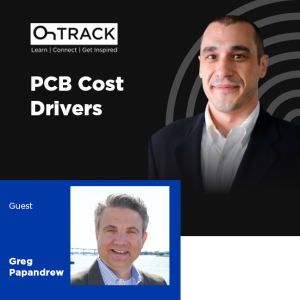
Tuesday Jan 10, 2023
Better PCB Buying with Greg Papandrew
Tuesday Jan 10, 2023
Tuesday Jan 10, 2023
Expedite your transition from prototype to scale with the help of an experienced PCB broker! In this episode, a returning guest joins us to discuss everything that involves cost-effective PCB manufacturing. Greg Papandrew, a PCB buying and selling expert, gives us a comprehensive understanding of PCB cost drivers and tips on a good supply chain strategy.
Show Highlights:
- The process of buying and selling, Greg Papandrew is a PCB broker with 30 years of experience in the industry
- Greg emphasizes the importance of quoting smartly, learning when, where, and how to save money without sacrificing the PCB quality
- What is a good supply chain strategy?
- Greg dives deep into his role as a PCB broker, and his involvement in the decision making involving specs, materials, cost, and more
- Sending too much information can be problematic, and it involves the vulnerability of intellectual property
- Good communication with the PCB manufacturer and fabricator can go a long way; asking the right questions can help with the production of high-quality products with a fair pricing
- What is the anatomy of a complete data package?
- What's in a File list and a README file
- Greg answers, at what stage of the process does a PCB designer or manufacturer approach a PCB broker?
Links and Resources:
Connect with Greg Papandrew on LinkedIn
Watch a previous episode with Greg Panandrew: How to Buy PC Boards From a Board Shop
Watch Greg’s video: How to Avoid Self-inflicted PCB Costs
Visit DirectPCB - Better Board Buying website
Connect with Zach on LinkedIn
Visit Nexar website
Visit Octopart website
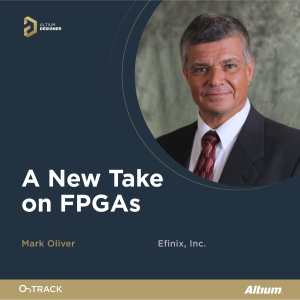
Tuesday Jan 10, 2023
FPGAs Are Moving Beyond Prototyping
Tuesday Jan 10, 2023
Tuesday Jan 10, 2023
If you look at the way people have used FPGAs, they are a miracle product in many ways. -Mark Oliver
Our guest Mark Oliver, VP of marketing at Efinix talks about the evolving role of FPGAs in the industry beyond prototyping. Mark will give us a very insightful use of FPGA as an efficient custom silicon solution and will go deep on the importance of RISC-V for processor designs.
Show Highlights:
- Introduction to Efinix, an FPGA company
- Mark starts off by addressing the inefficient ways designers use FPGAs and how this has helped them develop a product that can be utilized from prototyping and straight to high-volume manufacturing
- Efinix FPGAs are cost-effective, low-power, and small-form efficient for custom silicon solution
- The common FPGAs integration including the SIP (Session Initial Protocol) implementation
- FPGA market is set to explode because it is going in the same direction as the current industry growth
- they are designed as mid-volume production solutions with the potential for scalability
- Given that the industry is dominated by software engineers Efinix moves its course to RISC-V processor integration
- What is RISC-V and why it is so important for processor design, specifically for FPGAs?
- FPGAs already offer great benefits and there will be more to come
Links and Resources:
- Connect with Mark Oliver on LinkedIn
- Visit Efinix website
- Read Related Articles:
- Watch Related Altium Academy Videos:
- Connect with Zach on LinkedIn
- Full OnTrack Podcast Library
- Altium Website
Get Your First Month of Altium Designer® for FREE

